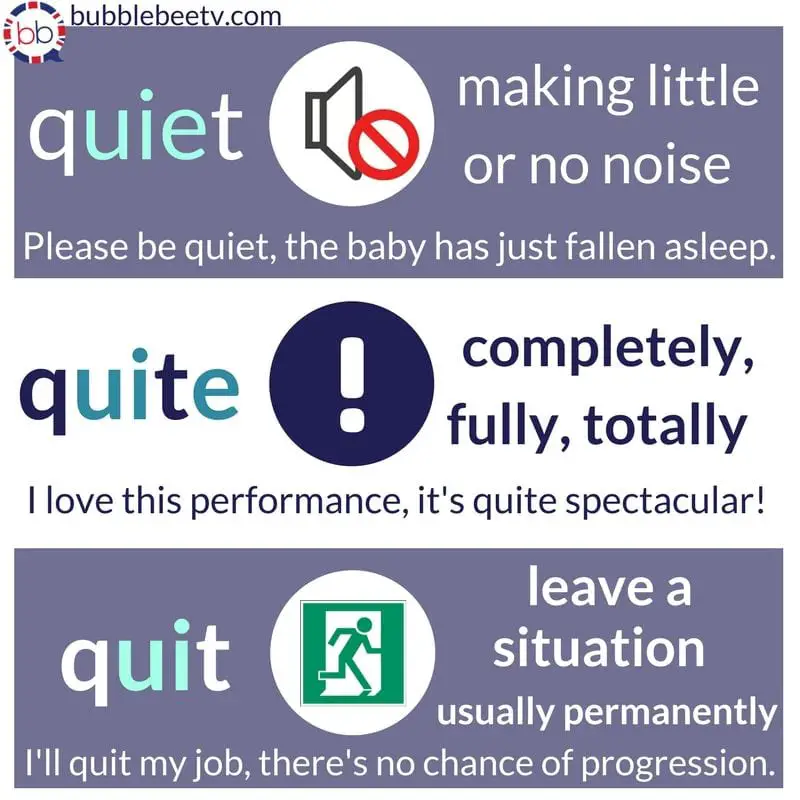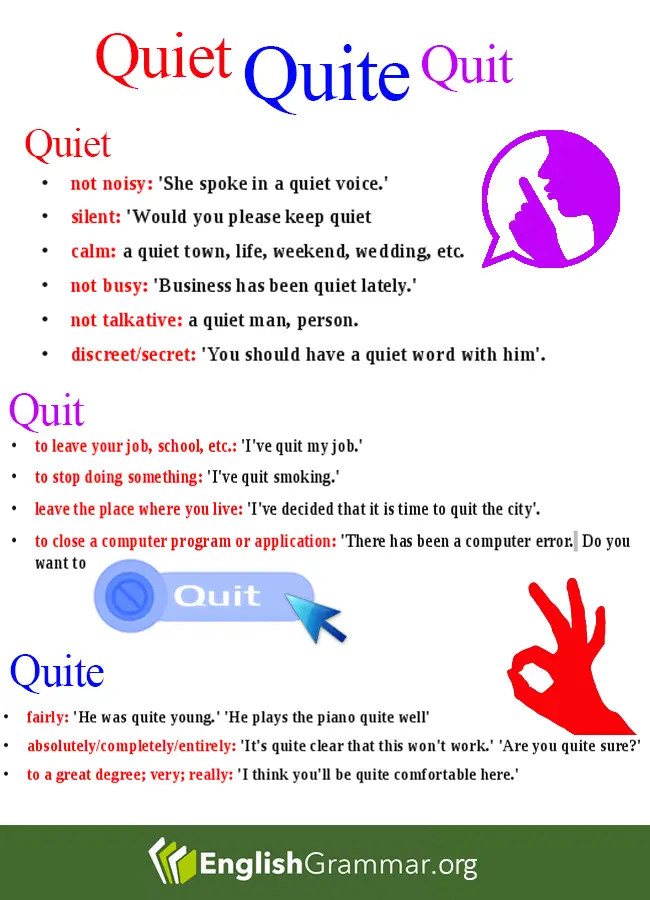Hello English learners! This blog is going to be about the differences between quite, quiet and quit. I think the most important thing is the pronunciation with each of these words. After I cover how to say the words, I will go over the definitions of these words.
👉 What does Quite mean?
The word quite is an adverb and it means really or very.
For example
- This bread is quite good. It might be the best bread I have ever eaten.
- She is quite lovely. (She is a great person)
- His new salary has made quite a difference in his life.
👉 Quite Silent
Quite silent means that something, or someone, is almost completely silent. Quite as an adjective or adverb means that something is in between being complete and unfinished. It is a kind of middle-ground.
When something is quite silent it could be even more silent, or it could be even louder.
- Considering he got home really drunk he was quite silent.
- I have to admit that vacuum cleaner is quite silent for an old model.
- The kids are quite silent, maybe even too silent. I have to check what’s going on.
👉 Quite Sound
When something is quite sound it means it’s plausible, or in good condition. Quite sound is usually used to describe ideas, plans, or the structural integrity of various things.
- Once she read the book and prepared her answers, her agreements became quite sound.
- That was quite a sound idea fro Jeff.
- The exterior of this boat is quite sound, so you don’t have to worry about leaks.

👉 What does Quiet mean?
Quiet can be used as both as an adjective or a verb.
As an adjective, quiet means silent or no sound or noise.
Here are some examples:
- You are too loud. Be quiet!
- We live on a quiet street, hardly any cars drive down our road.
- I like read the paper on a quiet Sunday morning.
When quiet is used as a verb, it means to make quiet or to silence.
Remember that a verb is an action, so when using the word quiet as a verb it will be an action.
Here are some examples:
- The dog was barking, so I had to quiet it.
- Her baby was crying during the movie, so she went to quiet it.
👉 Quite vs Quiet
Quite and quite are two different words with two different meanings. While they are spelled similarly, and often mixed up, using the wrong word can make the entire sentence wrong as well. Quite and quite also fulfill different roles in a sentence.
🧠 Quite is an adjective or adverb depending on the circumstance and position within the sentence. Quite means that something is between being very good and very bad.
- They bought a used car last week. Even though it’s used you could never tell since it looks and feels quite new.
- I generally don’t like seafood, but that seafood paella from last night was quite delicious.
- James doesn’t know him quite well, since they talk so rarely.
🧠 Quiet is an adjective. It means that something is very silent. It’s not completely silent, or soundless, but it’s close to that.
- I can’t get any quiet in this house, with the kids running around all the time.
- Can you be quiet for just a second, please?
- Sharon is always studying in the library because it’s so quiet there.
👉 The Spelling of Quite and Quiet
Quite and quiet use the same letters, and are often mistaken for one another. Quite is spelled with the E at the very end. Quiet is spelled with the E before the T.
👉 Quiet and Quite in a sentence
Quiet = silent
- It’s quiet in the forest, and the only thing you can hear are your footsteps.
- We love hiking to the top of the mountain and watching the starts at night. It’s so quiet and peaceful so we can relax.
- She’s been quiet all day. I’m afraid something might be wrong, but she won’t tell me.
- The summer was surprisingly quiet, with little tourists in the city.
- Thomas is a quiet boy. He likes to draw and keeps mostly to himself.
Quite = really, completely
- She’s got a quite a temper, and wouldn’t like being the one to give her the bad news.
- That’s quite the watch you have there. Where did you buy it?
- Jasmine doesn’t want to do the job. Quite frankly, neither do I.
- I’ve had quite a breakthrough yesterday.
- How could he do that to her? I found his actions quite insulting, but I didn’t expect much better from his either.
Test Yourself NOW!
Quite vs Quiet vs Quit Quiz › TEST YOURSELF
👩🏫 Are quiet and quite homophones?
Quiet and quite are not homophones. They don’t sound the same when pronounced, but they are quite similar. If a person talks fast one might mistake them for one another.
In any other case they should not sound the same.
👩🏫 Most quiet or quietest?
Both forms are correct. Quiet is one of the few words where both forms are correct. They mean the same thing, and can be used depending on personal preference.
👩🏫 Quiet busy or quite busy?
Quite busy is the correct phrasing.
👩🏫Quite sure or quiet sure?
The correct way to say or write the phrase is – quite sure.
👩🏫 Quite high or Quiet high?
Quite high is correct. Quiet high is incorrect.
👩🏫 Quite happy or quiet happy?
The correct expression is quite happy. Quiet happy is incorrect.
👩🏫 Keep quiet or keep quite?
Keep quiet is correct. Keep quite is incorrect.
👩🏫 Quiet good or quite a good?
Quiet good is incorrect. Quite a good can be use to describe a thing.
Example:
- That’s quite a good car. Is it new?
- Tiffany gave me quite a good idea yesterday.
- Quite a good throw he has. In the future he should play rugby.
👩🏫 Be quiet or Be Quite?
Be quiet is correct. Be quite is incorrect.
👩🏫 Quite big or Quiet big?
The correct expression is quite big. Quiet big is incorrect.
👩🏫 Quite easy or Quiet easy?
The correct way to say and write the expression is quite easy.
👩🏫 Quite far or Quiet far?
When you’re going somewhere you’re going quite far, not quiet far.
👩🏫 Quite late or Quiet Late?
If you’re late for something you’re quite late, not quiet late.
👩🏫 More Quiet or Quite?
When someone needs to be silent they need to be more quiet. More quite is not correct.
👩🏫 Not quite or Not quiet?
Not quite is the correct expression. Not quiet describes something loud, but it’s best to just use the word loud instead.
👩🏫 Quite often or Quiet often?
Quite often the correct expression for something that happens fairly regularly.
👩🏫 Quite well or Quiet well?
When someone is doing something fairly good, they are doing quite well.
👩🏫 You are quiet or quite?
There are different ways to use both. Quiet describes someone who does not say much. When someone is quite something they can be different things.
- You’re’ quiet today, what’s going on?
- You’re quite the magician, where did you learn those tricks?
👉 What does Quit mean?
The word quit is a verb and it means to stop or not finish.
For example
- I was so full from the meal, that I had to quit eating.
- She quit her job after six months.
- He quit his life in the city and moved to a rural area.


Skype English Lesson with a native AMERICAN or BRITISH teacher ››
👉 Quite
Let’s start with quite.
The pronunciation of quite has only one syllable. A syllable is an uninterrupted segment of speech, only making one sound.
For example these words only have one syllable:
- Ball
- Toy
- It
- Book
These words have two syllables:
- Table (ta-ble)
- Notebook (note-book)
- Coffee (cal-fee)
- Remote (re-mote)
👉 How do you spell quite?
The pronunciation of the word quite follows the phonetic pronunciation guide of [kwahyt] if that helps.
If you know the pronunciation guide, then great! If you don’t, then this next part is for you.
You need to remember that the word quite is one syllable. Keep that in mind as you are saying this word.
The first part of the word quite makes the Q sound. It is a combination of the K sound with a WA sound.
It looks like this:
K-WA (you need to pronounce this very quickly in order to get the Q sound).
I won’t go into too much depth of the anatomy that your mouth should be making, but I will say this.
It should look like you are trying to blow a bubble.
Put your lips out and make an O shape with your mouth.
After you make the K-WA sound, you need to change the sound to the I sound.
Your mouth will need to open very wide at this time.
Before, your mouth was small and in the O shape. Now it should be wide and you should be smiling. The sound so far it is pronounced K-WHY.
Be sure to practice just making this sound a couple of times. This sound is the hardest part in the pronunciation of quite.
Finally, we come to ending sound. It is a very short sound and it is the t sound.
In order to produce this sound, you should know that your tongue will do most all of the work. It is very important to focus on the position of the mouth as well as the tongue.
Go in front of a mirror or bring one close to your electronic device.
Let’s start with the position of the mouth.
Step 1: Make a BIG Smile (I am not kidding. Pretend that you are very happy to see someone.)
Step 2: Open your mouth a little bit. (Make sure you are still smiling. Your teeth should be showing. Hold this position for all of the steps).
Step 3: Pretend that you are biting a pencil with your front teeth. Your front teeth should be 0.7cm (the width of a pencil) apart.
Now let’s work on the position of the tongue.
Step 1: Cup your tongue like it is trying to hold water. (Make a cup with your hand, like you are trying to hold water. Your tongue should be making the same shape and curves).
Step 2: Place the tip of your tongue to the roof of your mouth. (Yes, it still needs to be making the cup shape and you should still be smiling with an imaginary pencil in your mouth.)
Step 3: Move your tongue so that it touches the roof of your mouth and the backside of your top teeth. (The tongue should be touching your front two teeth but on the inside of the teeth, where the gums meet the teeth.)
Step 4: Apply pressure with the TIP of your tongue to the back of your teeth. (The tongue is the strongest muscle in the body. Now push those teeth!)
IT IS VERY IMPORTANT THAT THE TIP OF THE TONGUE MAKES THIS SOUND! That way you get a sharp t sound.
Okay. Good. Now we are ready to make the t sound.
Your breathing is very important in making this sound correctly.
Do you know how you can check to see if your breath is bad or not? (You put your hand in front of your mouth and breathe to get that warm breath.) Don’t blow. Your breath should be hot and not cool or cold.
This is the breathing that you need to make the t sound.
Before you try this, I want you to practice a specific movement with your tongue that you are going to make when producing the t sound.
Movement with the tongue
Step 1: With your tongue in the position described above (behind the front teeth).
Step 2: Make sure the TIP of your tongue is pointed up touching those teeth.
Step 3: The TIP of the tongue will go from pointing up to POINTING DOWN (It will change position.)
In the start position, the tongue will be making a bowl or cup or U shape.
In the end position, the tongue will be making an upside-down bowl or upside-down cup or upside-down U shape.
The movement of the tongue from pointing up to pointing down needs to be moving at the SAME TIME that you are PUSHING AIR out of your mouth.
(Do you know the breathing technique I mentioned above? This needs to happen at the same time that your tongue is moving down.)
The sound you are trying to make is the T-A sound.
Practice this. Chances are you won’t get it the first time.
Pay close attention to ALL of the steps above when making this sounds to say quite!
Put all of the K-WHY T sounds together and you know can say quite correctly.
Quiet
The next word that I want to teach you to pronounce is quiet. The pronunciation guide is [kwahy-it]
This will be very similar to quite, however the word quiet has two syllables.
Let’s go.
The first part of the word quiet makes the Q sound. It is a combination of the K sound with a WA sound.
👉 How do you spell quiet?
It looks like this:
K-WA (you need to pronounce this very quickly in order to get the Q sound).
I won’t go into too much depth of the anatomy that your mouth should be making, but I will say this.
It should look like you are trying to blow a bubble.
Put your lips out and make an O shape with your mouth.
After you make the K-WA sound you need to change the sound to the I sound
Your mouth will need to open very wide at this time.
Before, your mouth was small and in the O shape. Now it should be wide and you should be smiling.
The sound so far is K-WHY.
Be sure to practice just making this sound a couple of times. This sound is the hardest part in the pronunciation of quiet.
The next sound, which will start the second syllable, is the E sound.
This sound requires you to smile even more after the K-WHY part. The sound should come from the back of your throat.
It should also come from the back TOP part of your throat.
Here are some examples of that sound:
- E-xample
- E-xcuse me
- E-lephant
The beginning sounds from the letter E in these words have that E sound that I am looking for.
Combine that with what we have learned previously.
K-WHY-E
Practice this a couple of times before going on to the t sound.
Now that you have practiced, let’s pronounce that final sound.
It is a very short sound and it is the t sound.
In order to produce this sound, you should know that your tongue will do most all of the work. It is very important to focus on the position of the mouth as well as the tongue.
Go in front of a mirror or bring one close to your electronic device.
Let’s start with the position of the mouth.
Step 1: Make a BIG Smile (I am not kidding. Pretend that you are very happy to see someone.)
Step 2: Open your mouth a little bit. (Make sure you are still smiling. Your teeth should be showing. Hold this position for all of the steps).
Step 3: Pretend that you are biting a pencil with your front teeth. Your front teeth should be 0.7cm (the width of a pencil) apart.
Now let’s work on the position of the tongue.
Step 1: Cup your tongue like it is trying to hold water. (Make a cup with your hand, like you are trying to hold water. Your tongue should be making the same shape and curves).
Step 2: Place the tip of your tongue to the roof of your mouth. (Yes, it still needs to be making the cup shape and you should still be smiling with an imaginary pencil in your mouth.)
Step 3: Move your tongue so that it touches the roof of your mouth and the backside of your top teeth. (The tongue should be touching your front two teeth but on the inside of the teeth, where the gums meet the teeth.)
Step 4: Apply pressure with the TIP of your tongue to the back of your teeth. (The tongue is the strongest muscle in the body. Now push those teeth!)
IT IS VERY IMPORTANT THAT THE TIP OF THE TONGUE MAKES THIS SOUND! That way you get a sharp t sound.
Okay. Good. Now we are ready to make the t sound.
Your breathing is very important in making this sound correctly.
Do you know how you can check to see if your breath is bad or not? (You put your hand in front of your mouth and breathe to get that warm breath.) Don’t blow. Your breath should be hot and not cool or cold.
This is the breathing that you need to make the t sound.
Before you try this, I want you to practice a specific movement with your tongue that you are going to make when producing the t sound.
Movement with the tongue
Step 1: With your tongue in the position described above (behind the front teeth).
Step 2: Make sure the TIP of your tongue is pointed up touching those teeth.
Step 3: The TIP of the tongue will go from pointing up to POINTING DOWN (It will change position.)
In the start position, the tongue will be making a bowl or cup or U shape.
In the end position, the tongue will be making an upside-down bowl or upside-down cup or upside-down U shape.
The movement of the tongue from pointing up to pointing down needs to be moving at the SAME TIME that you are PUSHING AIR out of your mouth. (Do you know the breathing technique I mentioned above? This needs to happen at the same time that your tongue is moving down.)
The sound you are trying to make is the T-A sound.
Practice this. Chances are you won’t get it the first time.
Pay close attention to ALL of the steps above when making this sound!
Put all of the K-WHY-E- T sounds together and you know can say quiet correctly.
Quit
The last word that I will discuss is quit. The phonetic pronunciation guide is [kwit].
The word “quit” has only one syllable and is shorter in sound than quite and quiet.
It will have the same beginning sound as quite and quiet, but then there is a different vowel sound that comes after the Q sound.
Let’s take a closer look.
The first part of the word quit makes the Q sound. It is a combination of the K sound with a WA sound.
👉 How do you spell quit?
It looks like this:
K-WA (you need to pronounce this very quickly in order to get the Q sound).
I won’t go into too much depth of the anatomy that your mouth should be making, but I will say this.
It should look like you are trying to blow a bubble.
Put your lips out and make an O shape with your mouth.
After you make the K-WA sound you need to change the sound to the E sound
Your mouth will need to open very wide at this time.
Before, your mouth was small and in the O shape. Now it should be wide and you should be smiling.
The sound so far is K-WH-E.
Be sure to practice just making this sound a couple of times. This sound is the hardest part in the pronunciation of quit.
This E sound requires you to smile even more after the K-WH part. The sound should come from the back of your throat.
It should also come from the back TOP part of your throat.
Here are some examples of that sound:
- E-xample
- E-xcuse me
- E–lephant
The beginning sounds from the letter E in these words have that E sound that I am looking for. Combine that with what we have learned previously.
K-WH-E
Finally, we come to ending sound. It is a very short sound and it is the “t” sound.
In order to produce this sound, you should know that your tongue will do most all of the work. It is very important to focus on the position of the mouth as well as the tongue.
Go in front of a mirror or bring one close to your electronic device.
Let’s start with the position of the mouth.
Step 1: Make a BIG Smile (I am not kidding. Pretend that you are very happy to see someone.)
Step 2: Open your mouth a little bit. (Make sure you are still smiling. Your teeth should be showing. Hold this position for all of the steps).
Step 3: Pretend that you are biting a pencil with your front teeth. Your front teeth should be 0.7cm (the width of a pencil) apart.
Now let’s work on the position of the tongue.
Step 1: Cup your tongue like it is trying to hold water. (Make a cup with your hand, like you are trying to hold water. Your tongue should be making the same shape and curves).
Step 2: Place the tip of your tongue to the roof of your mouth. (Yes, it still needs to be making the cup shape and you should still be smiling with an imaginary pencil in your mouth.)
Step 3: Move your tongue so that it touches the roof of your mouth and the backside of your top teeth. (The tongue should be touching your front two teeth but on the inside of the teeth, where the gums meet the teeth.)
Step 4: Apply pressure with the TIP of your tongue to the back of your teeth. (The tongue is the strongest muscle in the body. Now push those teeth!)
IT IS VERY IMPORTANT THAT THE TIP OF THE TONGUE MAKES THIS SOUND! That way you get a sharp t sound.
Okay. Good. Now we are ready to make the t sound.
Your breathing is very important in making this sound correctly.
Do you know how you can check to see if your breath is bad or not? (You put your hand in front of your mouth and breathe to get that warm breath.) Don’t blow. Your breath should be hot and not cool or cold.
This is the breathing that you need to make the t sound.
Before you try this, I want you to practice a specific movement with your tongue that you are going to make when producing the t sound.
Movement with the tongue
Step 1: With your tongue in the position described above (behind the front teeth).
Step 2: Make sure the TIP of your tongue is pointed up touching those teeth.
Step 3: The TIP of the tongue will go from pointing up to POINTING DOWN (It will change position.)
In the start position, the tongue will be making a bowl or cup or U shape.
In the end position, the tongue will be making an upside-down bowl or upside-down cup or upside-down U shape.
The movement of the tongue from pointing up to pointing down needs to be moving at the SAME TIME that you are PUSHING AIR out of your mouth. (Do you know the breathing technique I mentioned above? This needs to happen at the same time that your tongue is moving down.)
The sound you are trying to make is the T-A sound.
Practice this. Chances are you won’t get it the first time.
Pay close attention to ALL of the steps above when making this sound!
Put all of the K-WH-E-T sounds together and you know can say quit correctly.
Great work reading this post!
Feel free to come back to review the pronunciation.
Do you still have doubts? Schedule a lesson with one of our many qualified teachers here at www.myenglishteacher.eu
See you soon!



























